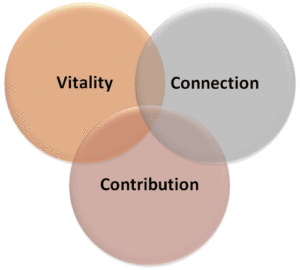Now entering my fourth month of quarantine, I’m getting lots of time to read (and re-read) a variety of books. This week, I re-encountered Jonathan Field’s book, How To Live A Good Life: Soulful Stories, Surprising Science, and Practical Wisdom.
If you haven’t read anything by Jonathan Fields, I encourage you to give this book a go. He’s a wonderful writer, and his advice strikes me as thoughtful and grounded in reality. As the Founder of the Good Life Project, he hosts a popular podcast to which I subscribe and also runs conferences for folks seeking to take their lives up a notch.
Jonathan’s formula for living a good life relies upon creating balance in each of three “buckets”:
 The VITALITY BUCKET acknowledges that we need to be feel sufficiently fit, energized, strong, and flexible to participate fully in life. It entails making life choices that minimize pain, disease, and disability (e.g., nutritious diet, daily exercise and stretching, good sleep habits, eliminating stress/tension). It calls for living peacefully in the moment with gratitude for what we have and optimism toward the future. (Not surprisingly, he’s a big fan of meditation!) It also means cultivating a growth mindset that is open to opportunity and bounces back from adversity.
The VITALITY BUCKET acknowledges that we need to be feel sufficiently fit, energized, strong, and flexible to participate fully in life. It entails making life choices that minimize pain, disease, and disability (e.g., nutritious diet, daily exercise and stretching, good sleep habits, eliminating stress/tension). It calls for living peacefully in the moment with gratitude for what we have and optimism toward the future. (Not surprisingly, he’s a big fan of meditation!) It also means cultivating a growth mindset that is open to opportunity and bounces back from adversity.
The CONNECTION BUCKET recognizes that we are fundamentally social creatures. We need to give and receive love. We need to be seen, understood, and embraced by folks who share our interests and values. And we need to connect to something that is larger than ourselves. To fill this bucket, we must do the inner work to understand ourselves well enough to identify our tribes while developing the skills to engage with integrity and compassion. We must also do the legwork to cultivate relationships. (Hint: We need to get our noses out of technology to do it!) Along the way, we can work toward becoming an increasingly better version of ourselves.
The CONTRIBUTION BUCKET entails knowing that we are doing what we’re meant to do and lighting up along the way. For many of us, this bucket may be the toughest to fill. We may have gotten so enmeshed in what life expected that we bypassed figuring out what really matters to us. Jonathan invites us to explore the following:
- Curiosity: Toward what do you feel a deep yearning to answer a burning question?
- Fascination: What subject matter triggers an intrinsic desire to learn?
- Immersion: In what activities do you become engaged and then lose all track of time?
- Mastery: What expertise or skills would you like to develop at the highest level?
- Service: Where do you feel most adept and/or energized when contributing to those around you?
He encourages us to identify key strengths (e.g., as revealed by things like the VIA Survey of Character Strengths). They may prove useful for identifying focal areas. Likewise, distinctive skills, talents, knowledge, and experience may come into play. That being said, we may not be excited about things at which we’re naturally gifted or acquired mastery. We’ll only fill our contribution bucket when we’re good at something for which we feel an inner spark.
All three buckets benefit from the art of saying NO. NO to patterns of behavior that drain our physical, mental, emotional, and spiritual resources. NO to relationships that distract us from our journeys or are otherwise energy vampires. NO to letting our heads talk us into jumping on paths that our hearts know would be wrong for us.
Finally, Jonathan tells us to “think ripple, not wave.” Simple actions, moments, and experiences delivered with intention and integrity can propel us to a good life.